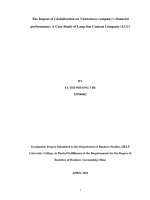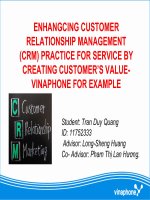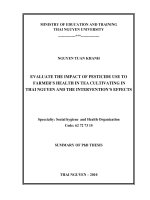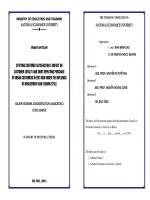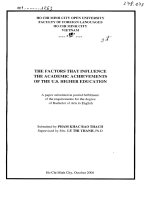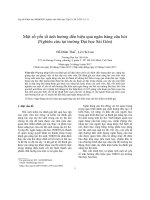Evaluate the factors that impact Vietnamese customer’s buying decision for non-life insurance product.
Bạn đang xem bản rút gọn của tài liệu. Xem và tải ngay bản đầy đủ của tài liệu tại đây (1.37 MB, 66 trang )
VIETNAM NATIONAL UNIVERSITY, HANOI
VIETNAM NATIONAL UNIVERSITY, HANOI
VIETNAM JAPAN UNIVERSITY
VIETNAM JAPAN
UNIVERSITY
--------------------
PHAN MINH HAI
PHAN MINH HAI
EVALUATE THE FACTORS THAT
IMPACT
VIETNAMESE
CUSTOMER’S
EVALUATE
THE FACTORS
THAT
BUYING
DECISION FOR
NON-LIFE
IMPACT
VIETNAMESE
CUSTOMER’S
INSURANCE
BUYING
DECISION PRODUCT
FOR NON-LIFE
INSURANCE PRODUCT
MASTER’S THESIS
MASTER OF BUSINESS ADMINSITRATION
MASTER THESIS
BUSINESS ADMINISTRATION
Hanoi, 2019
VIETNAM NATIONAL UNIVERSITY, HANOI
VIETNAM JAPAN UNIVERSITY
--------------------
PHAN MINH HAI
EVALUATE THE FACTORS THAT
IMPACT VIETNAMESE CUSTOMER’S
BUYING DECISION FOR NON-LIFE
INSURANCE PRODUCT
MAJOR: BUSINESS ADMINSITRATION
CODE: 60340102
RESEARCH SUPERVISORS:
ASSOC.PROF. DR. PHAM THI LIEN
PROF. DR. HIROSHI MORITA
Hanoi, 2019
ACKNOWLEDGEMENT
This is all my respectful gratitude that I place on express sincere thanks to all the
precious guidance, support and encouragement that I receive during researching and
completing Master of Business administration program at Vietnam Japan University.
Thanks to the guidance of Associate Professor Pham Thi Lien – Vietnam Japan
University and Professor Hiroshi Morita – Yokohama National University, who
always support and give me many in-times valuable instructions during my research,
this thesis has been completed. I own my heartfelt gratitude to my supervisors for
the advice given, orientations and instructions. Through many discussions during
the research process, with their insightful suggestions and extensively science
knowledge, I can improve research and completing for my Master thesis.
I also wish to express my sincere gratitude to Ms. Huong, Master of Business
administration program assistance for her in-times support and providing
information required any point of time during study time at Vietnam Japan
University.
I also want to express my heartfelt and grateful gratitude for my family support as
they constant encourage and support me.
Phan Minh Hai
ABTRACT
In this research, the author aims examine the factors that affect the customers’
inclination and purchase decision on non-life insurance products and measure the
different impacts weights of these factors, based on the results to propose some
recommendation for insurers to improve service quality in the future. To archive the
reliable answer to the research’s question, this study adopts qualitative research
method, online survey via social media platform and face-to-face interview was
applied to collect the data from 319 respondents. The results suggest that there are
two factors indirectly impact on consumer’s purchase decision through consumer’s
inclination, which are personal income and risk recognition, and four factors
directly impact on the consumer’s final decision, including consumer’s inclination,
sale promotion, insurer’s reputation and insurer’ online communication quality. The
author suggests some recommendations for insurance companies to enhance
business activities, including diversifying products, building a professional
consultant teams, and improve companies imagine.
CONTENTS
CHAPTER 1: INTRODUCTION ............................................................................1
1.1. Introduction .....................................................................................................1
1.2. Problem statement ..........................................................................................2
1.3. Purpose of the study .......................................................................................3
1.4. Objectives of the study ...................................................................................4
1.5. Research question ...........................................................................................4
1.6. Subjects and scope of the research ................................................................4
1.7. Structure of the research................................................................................5
CHAPTER 2: LITERATURE REVIEW ................................................................6
2.1. Overview about insurance .............................................................................6
2.1.1. Insurance concept .......................................................................................6
2.1.2. Insurance characteristics.............................................................................7
2.1.3. The differences between types of insurance ..............................................7
2.1.4. Vietnam’s insurance market overview .......................................................9
2.2. Customer behavior .......................................................................................11
2.2.1. Customer behavior concept ......................................................................11
2.2.2. Customer buying decision ........................................................................12
2.3. Research gap .................................................................................................15
2.4. Factors impact on consumers’ buying decision .........................................16
2.4.1. Personal income .......................................................................................16
2.4.2. Consumer risk recognition .......................................................................17
2.4.3. Consumer inclination ...............................................................................18
2.4.4. Insurer’s online communication quality ...................................................19
2.4.5. Insurer’s reputation...................................................................................20
2.4.6. Sale promotion .........................................................................................21
2.5. Theoretical model and research hypothesis ...............................................22
CHAPTER 3: RESEARCH METHODOLOGY .................................................26
3.1. Research purpose ..........................................................................................26
3.2. Research approach .......................................................................................26
3.3. Data collection process .................................................................................27
3.4. Questionnaire design ....................................................................................28
CHAPTER 4: DATA ANALYSIS AND DISCUSSTION ...................................35
4.1. Sample characteristics ..................................................................................35
4.2. Reliability analysis ........................................................................................36
4.3. Factor analysis ..............................................................................................42
4.4. Multiple regression method .........................................................................43
4.5. Finding and discussion .................................................................................46
CHAPTER 5: LIMITATION AND FUTURE RESEARCH ..............................50
CHAPTER 6: CONCLUSTION AND IMPLICATION .....................................51
REFERENCES ........................................................................................................53
LIST OF TABLES
Table 3.1. Describe of measured items .....................................................................34
Table 4.1. Personal profile of the respondents (Source: author) ...............................36
Table 4.2. Reliability analysis – Cronbach’s alpha index (Source: author)..............41
Table 4.3. Exploratory factor analysis (Source: author) ...........................................42
Table 4.4. Statistical measures of the first stage of the multiple regression analysis
(Source: author) .........................................................................................................44
Table 4.5. Statistical measures of the first stage of the multiple regression analysis
(Source: author) .........................................................................................................46
LIST OF FIGURES
Figure 2.1. Non-life insurance revenue growth rate in particular business sectors
(billion VND) (Source: Bao Viet Securities) ............................................................10
Figure 2.2. Consumer Decision-making process (Source: Charles W. Lamb, 2010) ....13
Figure 2.3. Factors Influencing Consumer Behavior (Philip Kotler & Gary
Armstrong, 2016) ......................................................................................................14
Figure 2.4. Model of rationale for insurance service purchase decision making
(source Aurelija Ulbinaitė and Marija Kučinskienė (2013)) ....................................23
Figure 2.5. Hypothetical research model about consumer purchase decision toward
insurance service (Source: author) ............................................................................25
Figure 3.1. Data collection process (Source: Yin (2003), Eisenhadt (1989)) ...........27
CHAPTER 1: INTRODUCTION
1.1. Introduction
After the Renovation (or “Doi Moi” in Vietnamese) campaign was implemented
since 1986, Vietnam has been becoming an emerging country in not only in
Southeast Asia area, but also in the whole world, which achieving significant
growth and improvements. Vietnam’s gross domestic product (GDP) has growth
sharply since Renovation, from only 6,5 billion in 1990 to 223,8 billion in 2017 1.
The rising in living standard lead to the creation of new consumer habit. Some
service industries are experiencing sharply growth rate, like health care, tourism and
especially financial service.
The non-life insurance market plays an increasingly important role in the
development of a country in general and the whole world in particular. The role of
non-life insurance reflects through economic stabilization, mitigation of losses and
risk prevention for organizations and individuals participating who bought
insurance in society when unfortunately encountering risks; contributing to creating
jobs and ensuring social security, etc. In daily life as well as in production, although
people may pay attention to prevent possible risks, anything could be happened. For
example, due to natural disasters such as storms, floods, earthquakes, etc. cannot be
forecasted accurately, it would result in property damages, life losses and
production and business stagnations. Social environment is also a cause of risk, like
traffic accidents, occupational accident, etc. People have taken many measures to
minimize losses caused by natural and social environmental risks. One of the
measures is transferring the costs of risks to the insurance companies.
In Vietnam, in financial service field, insurance market has grown sharply in recent
years and continues to be regarded as a prospective market. In particular, the
Vietnam’s demographic and economic development conditions are expected to
create further demand for insurance services both in non-life and life sectors. In the
1
/>
1
last decade, Vietnam’s insurance sector changed the legal system to transform
insurance market from a State-owned monopolist field to an intensive competitive
industry for both domestic and foreign insurers as new entrants. Despite the
economic downturn rooted from the financial crisis since 2008 in United State, with
an average annual GDP growth rate around 6% last 10 years2, not only domestic
companies but also foreigner enterprises are interesting in entrant Vietnam’s
insurance market. It is obviously that there is an intensive competition in
Vietnam’s insurance market. Gain marketing share from other competitors is a
difficult mission for each company. While Vietnam’s customer still not
acknowledge about the core and additional benefit of insurance products, most of
exiting companies have to use the price strategy to attract consumer.
With the booming of e-commerce, customers are now shifting from traditional
consumer to digital natives. It is raising an emergency issue for insurance: What
are the main factors which impact Vietnamese customers’ purchase decisions
for non-life insurance products?
1.2. Problem statement
Non-life insurance is a guarantee and reciprocity products, is the type of risk
transfer through which the insurance company commits to pay compensation when
an insurance event occurs in relation to material loss, human accident and
responsibility of the insured, so non-life insurance is very social. In Vietnam,
regarding to the rapidly increase of income, people are becoming more aware of the
issue of ensuring their safety, especially in saving, consumption and investment
behavior for safety. However, in general, the level of interest, understanding and
implementation of insurance activities of people is still limited. Therefore, non-life
companies in Vietnam are being struggled to engage with potential customers.
Because customers are misunderstanding or underestimate the values of non-life
insurance products, they seem tend to be driven by price or promotion over the
purchasing decisions.
2
/>
2
However, in recent years, because of the booming of social media and ecommercial trend, information could be accessed much easier, cheaper, faster and
more detail than ever before, they could research for the price comparison as well as
insurance condition, insurers’ reputation and claims’ experience. Moreover,
nowadays customers demand insurance films provide them intelligibility,
accessibility products that they could be experienced in other fields. Customers,
through the platform they choose, demands prices and benefit policies which they
want, supports and consultations when they need and only want to have contact
from insurers when they have claims or renewals. Base on insurers reputation and
regular basis, customer will happily to choose other companies and have little
inclination to build last long relationships. When the customers are considering the
benefits and values rather than the price, they offer policies and conditions which
tailored their requirements.
However, not many insurers in Vietnam, both domestics and foreigners could
recognize current situation. Understanding about the customers is lagging behind
the new trend of business when their techniques are changing dramatically by the
signification improved of internet and telecommunications’ businesses while they
still concentrate on products, risks management and ratings. Comparing with other
financial or service sectors that focus on customer experience like bank or tourism,
insurers need to change the way they approach to their customers.
1.3. Purpose of the study
Through the theoretical research on the factors affecting the buying decision toward
non-life insurance products of insurers participating in Vietnam’s market, I hope
that could help them to have further understanding about their customers and
improve their business activities.
In this research, I also attempt to establish a model which reflects the interplay
between the several factors and their impact weights on different stages of the nonlife insurance purchase decision making.
3
1.4. Objectives of the study
In this study, I focus on the following specific objectives:
-
To examine the factors that affect the customers’ inclination and purchase
decision on non-life insurance products;
-
To examine the different impacts weights of these factors;
-
To examine the relationships between customers’ inclination and purchase
decision.
1.5. Research question
To solve the above problems and purpose, I attempt to figure answers for the
following specific questions:
Main question:
-
What are the main factors which impact Vietnamese customers’ purchase
decisions for non-life insurance products?
Sub questions:
-
Is there significant different in the impact weights among factors that influent
Vietnam’s customer purchase decision toward non-life insurance products?
-
What factor has the most powerful effect on Vietnam customer purchase
decision?
1.6. Subjects and scope of the research
Research subject: Issues related to the buying decision on non-life insurance
product and the factors affecting customers’ buying inclination and decision.
Scope of research: this research focus on Vietnamese who are possible customers
or purchase non-life insurance products before of companies participating in
Vietnam’s insurance market.
4
1.7. Structure of the research
This research including 6 chapter. Chapter 1 is the overview of this this research,
introduction about the research’s problem and research’s questions. Chapter 2 is an
overview about the Vietnam’s insurance market, previous paper on consumer’s
behavior and insurance sector, and proposal research model. Chapter 3 is about the
research methodology and survey design. In chapter 4, the author discusses about
the data analysis process and results. In the chapter 5, this study mentions about the
research limitations and future study. And finally, in chapter 6, the author discusses
about this paper’s implications.
5
CHAPTER 2: LITERATURE REVIEW
2.1. Overview about insurance
2.1.1. Insurance concept
Currently there are many different concepts of insurance, because the concept of
insurance is built on each aspect of research fields (such as society, legal, economic,
technical, etc.). Through study, we can offer some concepts of Insurance as follows:
-
According to Justice Lawrence, insurance “is a contract by which the on party,
in consideration of a price paid to him adequate to the risk, becomes security to
the other that he shall not suffer loss, damage or prejudice by the happening of
the perils specified to certain things which may be exposed to them” (Tyagi,C.L
& Tyagi,M., 2007, p. 1).
-
In another book, the term insurance is defined as “a method by which interested
members of a society can band together and collect funds to pay losses suffered
later by members of the group” (Marshall Wilson Reavis III, 2012, p. 2;
Schiffman, 2013).
-
Vietnam’s Law on Insurance Business, insurance business means “activity of an
insurance enterprise with the objective of profit, in which the insurance
enterprise accepts risks of an insured person on the basis of the purchaser of
insurance paying a premium in order for the insurance enterprise to pay
insurance proceeds to the beneficiary of the insurance or to indemnify the
insured person on the occurrence of the insured event”.
Therefore, Insurance is a business activity that express the insurer’s commitment to
compensate the insured in each case of the risks occurring during the coverage
period (coverage period is an insured time period is stated in the policy or insurance
certificate) by the insurer. This means that the insured transfers the consequences of
the risk to the insurer by paying a fee to form a reserve fund. When related expenses
or consequences due to insurance risk occurring during the coverage period, insurer
uses the reserve fund to reimbursement the insured partly or all of cost these
6
expenses or consequences. However, the insurer only reimbursement for the risks
which are in the written contract signed by and between insurer and the insured.
2.1.2. Insurance characteristics
Uncertainty is at the heart of insurance. In the “real” world all our activities depend
on uncertain and unknown circumstances beyond the control of a single individual
(Peter Zweifel & Roland Eisen, 2012, p. 1). Although we may be awareness about
uncertain events that could happened, it still can cost disastrous financial and human
cost risks.
Usually, (re)insurance companies are characterized as a risk warehouses (Nowak,
2014, p. 2). Insurance is a social device of sharing the risk in a community when
people in this social could be suffered same type of risk, by each person in the
community contributing a certain amount of money to a common fund. and from
such a general fund to compensate for the losses of the members of the community
who are unfortunately damaged by the risk.
Insurance is a way of risk management, which is a type of financial risks
managements, used to deal with losses which usually are financial and human losses.
Obviously, individuals could apply a wide range of methods, measures to prevent,
transfer and deal with the uncertain or risks. However, Insurance is, however, of
particular importance for risks with negative consequences (which corresponds to
the colloquial meaning of “risk”) (Peter Zweifel & Roland Eisen, 2012, p. 2).
2.1.3. The differences between types of insurance
Definition of Life insurance and Non-life insurance
Insurance is a very broad and abstract concept; therefore, it is difficult to apply a
general definition to both insurance and non-life insurance because the
characteristics of these two types of insurance is very different. Typically, in
Vietnam's Insurance Business Law, life and non-life insurance are defined in an
abstract way:
-
Life insurance means a class of insurance provided to cases where the insured is
alive or dead;
7
-
Non-life insurance means a class of property, civil liability and other insurances
other than life insurance.
In the book Insurance Law and Practice, the author mentioned the term life
insurance as “a contract in which one party agrees to pay given sum on the
happening of particular event contingent upon the duration of human life, in
consideration of the payment of a sum by another. Thus, insurer pays a sum assured
on survival up to a certain specified period or death” (Tyagi,C.L el al., 2007, p. 21).
According to AIG, “A life insurance policy is a protective contract between the
insured and an insurer (the life insurance company). In the event of your passing,
the life insurance company pays your beneficiary (a person or organization that the
insured choose) a set amount of money (benefit amount)”3.
So, to summarize, life insurance is a commitment between the insurer and the
insured in which the insurer will pay the participant (or beneficiary of this insurance
commitment) a certain amount when a certain event occurs (the insured person is
dead or still alive up to a certain time signed in the insurance contract). Life
insurance is usually a long-term contract and depend on the human life.
Non-life insurance is defined as an agreement between an insurance company and a
customer – a policy holder – in which the insurer undertakes to compensate the
customer for certain unpredictable losses during a time period, usually one year,
against a fee, the premium. A non-life insurance policy may cover damages on a car,
house or other property, or losses due to bodily injury to the policyholder or another
person (third party liability); for a company, the insurance may cover property
damages, cost for business interruption or health problems for the employees, and
more (Esbjörn Ohlsson & Björn Johansson, 2010, p. 1)
According to Bao Viet Insurance, non-life insurance is the type of insurance to
which cover the risks that are stabled over time and often independent of human life.
Therefore, this type of insurance policy is usually short term.4
3
/> />4
8
The different between Life insurance and Non-life insurance.
-
Life insurance is the only type of insurance that will pay for the insured whether
there is a risk, or no risk occurred. However, non-life insurance companies’
reimbursement for the insured depend on the particular financial costs result
from the insured risks written on the contract. This is fundamental difference
between non-life insurance and life insurance.
-
Life insurance is one of saving types, has some similar characteristics with the
banking saving. However, non-life has no component of saving.
2.1.4. Vietnam’s insurance market overview
Compared with Western insurance markets with hundreds of years of establishment
and development, Vietnam Insurance market is a very new market and consumer
habits have not been fully formed. In 1965, Bao Viet Insurance was formed, it was
the first insurance company established in Vietnam and was a state-owned
monopoly. In the early years, Bao Viet only provided marine insurance for example
insurance for import and export goods, ocean marine insurance, etc.
Until December 1993, when Vietnamese Government 100 Decree on insurance
business was issued, Vietnamese insurance market became a fully competitive
market, creating a potential platform for development. According to this
government decree, Insurance Bao Viet was no longer the monopoly company in
the market. Since then, many other Vietnamese insurance companies have
established, and many foreign companies have joined the Vietnamese insurance
market, providing all types of insurance (both life and non-life).
9
With 95.5 million population and 2,100 USD GNI per capital 5 , Vietnam is a
potential market for insurance companies. In Vietnam, since recent years insurance
companies’ revenues is increasing significantly despite the global economic crisis
happened in 2008 from United Stated. According to the Annual report of Vietnam
Insurance market 2017 (2018, p. 9), the revenue growth rate is 23,4% in compare
with the previous year.
Figure 2.1. Non-life insurance revenue growth rate in particular business sectors
(billion VND) (Source: Bao Viet Securities)
Up to 31st December 2017, In Vietnam’s insurance market, there are 64 companies
providing non-life insurance, life insurance, reinsurance and insurance brokerage
service (with 30 non-insurers) (2018, p. 5). However, also according to the annual
report the Ministry of Finance, the contribution of insurance services to Vietnam's
GDP is only over 2% (2018, p. 8).
5
/>
10
In recent years, with efforts to enhance policies and improve legal regulations in the
insurance business sector to advance the investment environment and administrative
reform of the Vietnamese government, Vietnam insurance market will attract more
reputable investors, and become more effective operation, healthy competition
market. Therefore, Although Vietnam's insurance market seems to be a fiercely
competitive once, it will be a market with a lot of development potential. What
insurance companies need to do is have further understanding about their consumer
behavior.
2.2. Customer behavior
2.2.1. Customer behavior concept
Marketing experts and researcher always regard customer behavior as a hot topic on
this area. Hawkins D.I., Mothersbauch D.L. & Best R.J (2007) emphasized the
important of the knowledge about customer behavior as all marketing decisions are
based on assumptions and knowledge of consumer behaviour. The more they are
understanding about the reason and the way customers response while making their
purchase decisions, the more they could advance their marketing strategies and gain
more successful.
Customer behavior, according to Leon Schiffman (2013, p. 4), is defined as the
behavior that consumer display in searching for, purchasing, using, evaluation and
disposing of the products and services that they expect will satisfy their needs.
Nowadays, researchers still concentrate on the study of how individuals make
decisions to spend their available resources (time, money, effort) on consumptionrelated items (Schhiffman J.B & Kanuk Lealie Lazar, 1997).
As retailing must keep pace and remain vigilant in the pursuit of deeper customer
understanding (Puccinelli, N., Goodstein, R., Grewal, D., Price, R., Raghubir, P. &
Stewart, D., 2009), this research also study about customer behavior, concentrate on
customer buying decision, specifically on finding out factors that influence
customers’ buying decision making in Vietnam non-life insurance market.
11
2.2.2. Customer buying decision
Because customer behavior is always a hot topic in marketing, there are many
studies on this field. According to Philip Kotler & Gary Armstrong (2016, p. 692)
they defined consumer buyer behavior refers to the buying behavior of final
consumers – individuals and households that buy goods and services for personal
consumption. In another research, consumer purchase is defined as a process of
gathering and processing information, evaluating it and selecting the best possible
option to solve a problem or make a buying choice (Komal Prasad, Ram & Jha,
Manoj, 2014).
There are four types of consumer buyer behavior (2016, pp. 182-183), which are:
-
Complex buying behavior is the consumer buying behavior in situations
characterized by high consumer involvement in a purchase and significant
perceived differences among brands.
-
Dissonance-reducing buying behavior, this type occurs when consumers are
highly involved with an expensive, infrequent, or risky purchase but see little
difference among brands.
-
Habitual buying behavior, this type occurs under the situations characterized by
low consumer involvement and few significant perceived brand differences.
-
Variety seeking buying behavior, consumers undertake this type in situation
characterized by low consumer involvement but significant perceived brand
differences.
Actually, buying decision is a part of the process and activities people engage
(Belch, 1978) starting from recognizing a need through how you feel after making
the purchase (2016, p. 183). Customers would experience some certain steps while
considering buying decisions. Depending on different research field, researcher’s
proposal different step model of consumer buying process. According to Charles W.
Lamb, consumer decision-making process is a five-step process used by consumers
when buying goods or services, which included: (1) need recognition, (2)
information search, (3) evaluation of alternatives, (4) purchase, and (5) post
purchase behavior. (2010, p. 191).
12
Figure 2.2. Consumer Decision-making process (Source: Charles W. Lamb, 2010)
Researchers traditionally study about the Five-stage model of consumer buying
decision when they want to understand further about their customer. For example,
Engel, Kollat and Blackwell (1968) in their researches proposal a model
demonstrating five-stages of consumer decision process which including problem
recognition, internal search and alternative evaluation, external search and
alternative evaluation, purchasing processes and outcomes. Kotler and Keller (2016)
describe consumer decision making process as a five-stages model, in which
consumer will involve in problem recognition, information search, evaluation of
alternatives, purchase decision and post-purchase behavior. Belch G. & Belch M.
(2014) in their book also discuss this five-stages model in the influence of various
psychological concepts, including motivation, perception, attitude formation,
integration and learning.
13
However, Kotler and Keller (2016) in their book pointed out that, consumer don’t
always follow all the stages in the decision making process, they may skip or
reserve some while making purchase decisions. The path which consumer moves
through the decision-making process would be differed by certain factors, including
cultural factors, social factors and personal factors (2005). Many levels of factors
affect consumer’s purchase decision – from broad cultural and social influences on
motivations, beliefs, and attitudes lying deep within consumers’ themselves.
Consumer purchase decision are impacted strongly by cultural, social, personal, and
psychological characteristics, as shown in figured 2.3 below.
Figure 2.3. Factors Influencing Consumer Behavior (Philip Kotler & Gary
Armstrong, 2016)
14
2.3. Research gap
Although customer behavior always has been widely studied and getting more
interested in when information technology, especially internet of thing, has been
considerable influencing on consumer buying decision; there is a limited on the
attention on the analysis of the particularities of insurance consumer behavior as a
specific object (Ulbinaite, Aurelija & Kučinskienė, Marija, 2013).
In financial field, especially banking sector, research is paying a lot of attention in
studying customer behavior, for example Capuano & Ramsay (2011), Milner &
Daniela (2013), Pousttchi & Maik (2018), Leong & Hibbert & Ennew (2018), etc.
However, there is a lack of identifying and systematically modelled the various
factors that impact the customer purchase decision in insurance sector, especially in
non-life insurance service.
Another problem is that in overall, research on insurance field often focus on purely
monetary decisions. Hsee & Kunreuther (2000) pointed out usually researchers
concentrate on consumer purchase decisions which depend on well-specified
quantitative factors, such as premium, probability of loss, and size of compensation.
With the fast development of information technology and the wide spread of new
business trend, for example e-commercial, the consumer behavior is now much
more complicated, influenced by various factors, from sociological, cultural,
economical to demographical factors. And insurance sector also cannot stay out of
these global trends. Researchers and experts should have a wider overview of the
factors that influence customer decisions in insurance sector.
In recent year, insurance business is increasingly receiving attention from researcher,
however it is usually assumed that they are much more focusing in life insurance
once (Jain & Kunal (2012); Bansal A, Goel S, Singh A, Singh AA, Goel AK, Naik
SM, et al (2015); Sandeep Chaudhary (2016), etc.). There are research gaps
between life insurance and non-life insurance field, also in geographical when
South East Asia countries do not get many attentions.
15
2.4. Factors impact on consumers’ buying decision
2.4.1. Personal income
Personal income is a term referring to all income of an individual earned in a certain
time period from salary, investment and other sources of ventures. In economic, this
term has a broader view as it is the gross of total earning of individuals or
household. A country’s personal income level and GDP have a positive relationship,
when the GDP increase, personal income also increase, and when the income
increase tends to create an increase in consumption, according to basically
economic theory. Peter Zweifel & Roland Eisen (2012, p. 17), in their book, figure
out that the demand for insurance increases proportionally with GDP, although
there is a difference between the increase in life and non-life insurance.
The relationship between personal income and insurance purchase decision is
widely studied. Many scientific-based reasons for non-consumption of insurance
services are strongly concentrated in economic state and purchasing ability (low or
no income) of individuals (Ulbinaite, 2013). According to Liu & Chen (2002)
research, income have a potential relationship with insurance purchase decision as
people are more willing to purchase insurance when income increases. In another
research in United State insurance market, Leiyu Shi (2001) pointed out that uninsurance and partial insurance are associated with low income. According Bawa &
Ruchita (2011), while researching for the impact of demographical on willingness
to purchase health insurance, figured out that income of respondents along with
other demographical factors (gender, age, education and occupation) has significant
association with their willingness to pay for insurance. In a broader research on the
impact of level of education on insurance purchase decision, Diane M. Dewar (1998)
also found out that in general, higher salaries, higher education levels, or
employment in industries with higher concentrations of college-educated employees
have a higher interest in taking insurance coverage.
16
From these previous research evidence, in this study about Vietnam’s customer
insurance purchase decision, the result is expected that in Vietnam, personal income
also have a positive impact on consumer willing to purchase insurance products.
2.4.2. Consumer risk recognition
In daily life, people could face many uncertain events that they cannot predict, and
these events could cause some possible losses. In insurance economic, these losses
due to these discrepancies in terms of money or utility are called risk (2012, p. 26).
Risk recognition, according to Nick Pidgeon (1998) is “the perception to include
people's beliefs, attitudes, judgements and feelings, as well as the wider cultural and
social dispositions they adopt towards threats”. Cognition about insurance is defined
as “insurance consciousness which determines the motivation of insurance
consumption” (Zhang, Xumei & Zhang, Yingxiu & Qiu, Hanguang & Dan, Bin,
2007).
According to the insurance definition above, insurance companies have the function
of allocation and managing risks more effectively when insurance buyers transfer
risks to them. Therefore, it could be logical to assume that when customers have
cognition (by themselves or by consulting) about the risks they may have to face,
they would tend to consider buying insurance as a protection measure.
In traditional five-steps model of consumer purchase decision, consumer knowledge
(or awareness) about the products or services they are thinking about always is the
first step of the process. In the model of Charles W. Lamb (2010, p. 191) the buying
process starts with consumer need cognition, while according to Philip Kotler &
Gary Armstrong (2016, p. 176), the first step in the model is consumer recognition –
the buyer recognizes a problem or need.
Cause the uncertainty is the heart of insurance and insurance business is the
business of risk, researchers want to understand more about the customer they have
to put some attention on studying the relation between customer risk recognition
and willing to purchase insurance. Ming Wang et al (2012) investigated in
analyzing about the impact of Chinese people’s risk awareness on insurance
17

